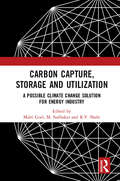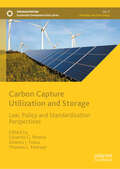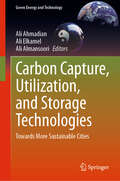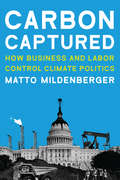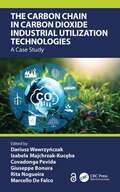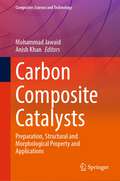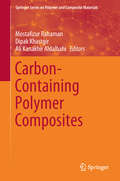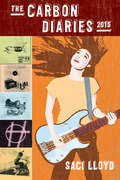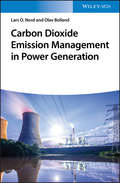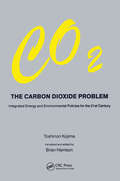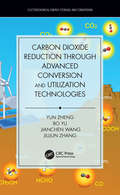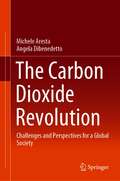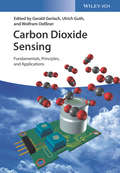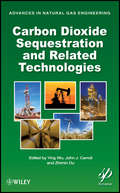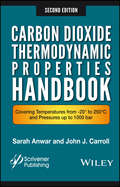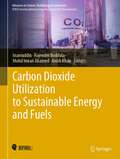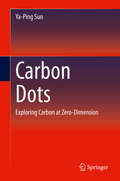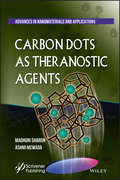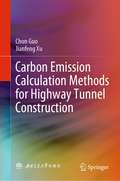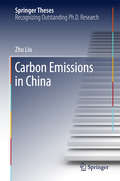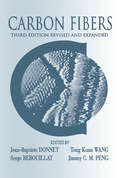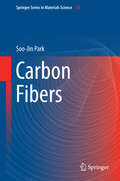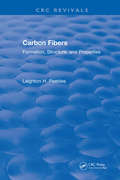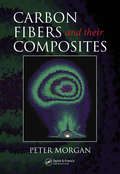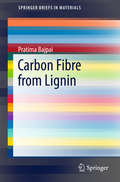- Table View
- List View
Carbon Capture, Storage and Utilization: A Possible Climate Change Solution for Energy Industry
by Malti Goel M. Sudhakar R. V. ShahiCarbon capture and storage (CCS) is among the advanced energy technologies suggested to make the conventional fossil fuel sources environmentally sustainable. It is of particular importance to coal-based economies. This book deals at length with the various aspects of carbon dioxide capture, its utilization and takes a closer look at the earth processes in carbon dioxide storage. It discusses potential of Carbon Capture, Storage, and Utilization as innovative energy technology towards a sustainable energy future. Various techniques of carbon dioxide recovery from power plants by physical, chemical, and biological means as well as challenges and prospects in biomimetic carbon sequestration are described. Carbon fixation potential in coal mines and in saline aquifers is also discussed. Please note: This volume is Co-published with The Energy and Resources Institute Press, New Delhi. Taylor & Francis does not sell or distribute the Hardback in India, Pakistan, Nepal, Bhutan, Bangladesh and Sri Lanka
Carbon Capture Utilization and Storage: Law, Policy and Standardization Perspectives (Sustainable Development Goals Series)
by Eduardo G. Pereira Alberto J. Fossa Thomas L. MuinzerThis book delves into how carbon capture, utilization, and storage (CCUS) technologies might help accelerate the worldwide transition to sustainable energy while meeting Paris Agreement targets. This comprehensive handbook examines how governments, businesses, and society may effectively implement CCUS programs to cut carbon emissions and promote economic development. The book begins with basic ideas and exposes readers to CCUS technologies and their critical role in reaching net-zero emissions by 2050. It investigates successful CCUS installations from various countries and suggests prospects for host governments and energy firms. The book combines technical innovation and carbon neutrality initiatives, while also addressing regulatory frameworks and normative factors that are critical for wider acceptance. With climate change mitigation at its core, the book offers pragmatic recommendations for policymakers and industry leaders on how to employ CCUS for sustainable development, making it a valuable resource for environmental researchers, energy professionals, and policymakers working toward a low-carbon economy.
Carbon Capture, Utilization, and Storage Technologies: Towards More Sustainable Cities (Green Energy and Technology)
by Ali Ahmadian Ali Elkamel Ali AlmansooriThis book brings together cross-disciplinary research on carbon capture, utilization, and storage (CCUS) to examine the impact of implementing CCUS tools and technologies on emissions reduction and sustainable development in cities and large metropolitan areas. An expert group of global contributors provides in-depth technical discussions, case studies, and examples with an emphasis on the worldwide application of the latest developments in technology, protocols, implementation, and application of CCUS in power and energy systems.Carbon Capture, Utilization, and Storage Technologies: Towards More Sustainable Cities is an essential multidisciplinary reference for researchers and industry practitioners from engineering, energy, computer science, data science, economics, and operational research working in the energy and environmental fields.
Carbon Captured: How Business and Labor Control Climate Politics (American and Comparative Environmental Policy)
by Matto MildenbergerA comparative examination of domestic climate politics that offers a theory for cross-national differences in domestic climate policymaking.Climate change threatens the planet, and yet policy responses have varied widely across nations. Some countries have undertaken ambitious programs to stave off climate disaster, others have done little, and still others have passed policies that were later rolled back. In this book, Matto Mildenberger opens the “black box” of domestic climate politics, examining policy making trajectories in several countries and offering a theoretical explanation for national differences in the climate policy process.Mildenberger introduces the concept of double representation—when carbon polluters enjoy political representation on both the left (through industrial unions fearful of job loss) and the right (through industrial business associations fighting policy costs)—and argues that different climate policy approaches can be explained by the interaction of climate policy preferences and domestic institutions. He illustrates his theory with detailed histories of climate politics in Norway, the United States, and Australia, along with briefer discussions of policies in in Germany, Japan, the United Kingdom, and Canada. He shows that Norway systematically shielded politically connected industrial polluters from costs beginning with its pioneering carbon tax; the United States, after the failure of carbon reduction legislation, finally acted on climate reform through a series of Obama administration executive actions; and Australia's Labor and Green parties enacted an emissions trading scheme, which was subsequently repealed by a conservative Liberal party government. Ultimately, Mildenberger argues for the importance of political considerations in understanding the climate policymaking process and discusses possible future policy directions.
The Carbon Chain in Carbon Dioxide Industrial Utilization Technologies: A Case Study
by Dariusz WawrzyńczakA shift towards implementation of renewable energy has disadvantages, such as power availability, storage capacity, and accompanying costs, and therefore the potential of clean fossil fuel technologies to ensure the stability of electricity generation needs to be reconsidered until these challenges will be overcome. These clean technologies can help prevent the greenhouse effect and, at the same time, guarantee energy security, as coal is a widespread, price-stable raw material that is available in large quantities. This book focuses on the carbon chain, starting from the formation of CO2, through its capture, possible cleaning, to the production of useful products such as dimethylether, methanol, and carbonated cement prefabricates. The comprehensive case study presents the research results of an international team established within the "CCS-CCU technology for carbon footprint reduction using bio-adsorbents" (BIOCO2) project.
Carbon Composite Catalysts: Preparation, Structural and Morphological Property and Applications (Composites Science and Technology)
by Mohammad Jawaid Anish KhanThis book provides an overview of the fundamentals and recent advances in the field of carbon composite catalysts, including graphene, carbon nanotubes, mesoporous carbons, graphitic carbon nitrides, and related composites. Special focus is placed on their controllable preparation and applications in the gas phase, liquid phase, electrochemical, and photocatalytic reactions, as well as defect and surface chemistry-related catalytic activities of carbon materials. Some perspectives are highlighted on the development of more efficient carbonaceous catalysts featuring high stability, low cost, optimized structures, and enhanced performance, which are the key factors to accelerate the designed preparation and commercialization of carbon composite catalysts. The book will also present the latest studies of carbon-based composite catalysts for clean energy change and storage, nature protection, and essential industrial production and storage and include the key challenges and future opportunities in this exciting field.
Carbon-Containing Polymer Composites (Springer Series on Polymer and Composite Materials)
by Mostafizur Rahaman Dipak Khastgir Ali Kanakhir AldalbahiThis book discusses the methods synthesizing various carbon materials, like graphite, carbon blacks, carbon fibers, carbon nanotubes, and graphene. It also details different functionalization and modification processes used to improve the properties of these materials and composites. From a geometrical–structural point of view, it examines different properties of the composites, such as mechanical, electrical, dielectric, thermal, rheological, morphological, spectroscopic, electronic, optical, and toxic, and describes the effects of carbon types and their geometrical structure on the properties and applications of composites.
The Carbon Diaries 2015
by Saci LloydIt's the year 2015, and global warming is ravaging the environment. In response, the United Kingdom mandates carbon rationing. <P><P>When her carbon debit card arrives in the mail, sixteen-year-old Laura is just trying to handle the pressure of exams, keep her straight-X punk band on track, and catch the attention of her gorgeous classmate Ravi. <P><P>But as multiple natural disasters strike and Laura's parents head toward divorce, her world spirals out of control. <P><P>With the highest-category hurricane in history heading straight toward London, chronicling the daily insanity is all Laura can do to stay grounded in a world where disaster is the norm.
Carbon Dioxide Emission Management in Power Generation
by Prof. Lars O. Nord Prof. Olav BollandProvides an engaging and clearly structured source of information on the capture and storage of CO2 Designed to bridge the gap between the many disciplines involved in carbon dioxide emission management, this book provides a comprehensive yet easy-to-understand introduction to the subject of CO2 capture. Fit for graduate students, practicing process engineers, and others interested in the subject, it offers a clear understanding and overview of thermal power plants in particular and of carbon dioxide capture and storage (CCS) in general. Carbon Dioxide Emission Management in Power Generation starts with a discussion of the greenhouse effect, climate change, and CO2 emissions as the rationale for the concept of CCS. It then looks at the long-term storage of CO2. A chapter covering different fossil fuels, their usage, and properties comes next, followed by sections on: CO2 generation, usage and properties; power plant technologies; theory of gas separation; power plant efficiency calculations; and classification of CO2 capture methods. Other chapters examine: CO2 capture by gas absorption and other gas separation methods; removing carbon from the fuel; pre- and post-combustion CO2 capture in power cycles; and oxy-combustion CO2 capture in power cycles. -Discusses both CO2 capture technologies as well as power generation technologies -Bridges the gap between many different disciplines?from scientists, geologists and engineers, to economists -One of the few books that covers all the different sciences involved in the capture and storage of CO2 -Introduces the topic and provides useful information to the academic as well as professional reader Carbon Dioxide Emission Management in Power Generation is an excellent book for students who are interested in CO2 capture and storage, as well as for chemists in industry, environmental chemists, chemical engineers, geochemists, and geologists.
Carbon Dioxide Problem: Integrated Energy and Environmental Policies for the 21st Century
by Toshinori KojimaThe problems of global warming and environmental pollution are some of the most difficult challenges this planet faces in the 21st century. Carbon dioxide, often identified as one of the culprits, is an inevitable product of the combustion of fossil fuels, necessary for our modern economies to survive. Thus, The Carbon Dioxide Problem refers to the extremely complex matter of limiting carbon dioxide concentrations to levels that pose little environmental risk without devastating national economies and reducing living standards on the planet. This timely book offers solutions to the global warming problem that lie in the development of comprehensive energy and environmental policies that emphasize the need to use energy efficiently while looking to develop alternative renewable sources. The experience of Japan is particularly relevant due to that country's great dependence on foreign fuel supplies, which has led it to be at the forefront of developing new energy conservation and antipollution technologies.
Carbon Dioxide Reduction through Advanced Conversion and Utilization Technologies (Electrochemical Energy Storage and Conversion)
by Bo Yu Jiujun Zhang Yun Zheng Jianchen WangCarbon Dioxide Reduction through Advanced Conversion and Utilization Technologies covers fundamentals, advanced conversion technologies, economic feasibility analysis, and future research directions in the field of CO2 conversion and utilization. <P><P>This book emphasizes principles of various conversion technologies for CO2 reduction such as enzymatic conversion, mineralization, thermochemical, photochemical, and electrochemical processes. It addresses materials, components, assembly and manufacturing, degradation mechanisms, challenges, and development strategies. Applications of conversion technologies for CO2 reduction to produce useful fuels and chemicals in energy and industrial systems are discussed as solutions to reduce greenhouse effects and energy shortages. Particularly, the advanced materials and technology of high temperature co-electrolysis of H2O and CO2 to produce sustainable fuels using solid oxide cells (SOCs) are reviewed and the introduction, fundamentals, and some significant topics regarding this CO2 conversion process are discussed. <P><P>This book provides a comprehensive and clear picture of advanced technologies in CO2 conversion and utilization. Written in a clear and detailed manner, it is suitable for students as well as industry professionals, researchers, and academics.
The Carbon Dioxide Revolution: Challenges and Perspectives for a Global Society
by Michele Aresta Angela DibenedettoThis book focuses on carbon dioxide and its global role in our everyday life. Starting with society's dependency on energy, it demonstrates the various sources of carbon dioxide and discusses the putative effects of its accumulation in the atmosphere and its impact on the climate. It then provides an overview of how we can reduce carbon dioxide production and reviews innovative technologies and alternative energy resources. The book closes with a perspective on how carbon dioxide can be utilized reasonably and how mimicking nature can provide us with a solution. Using simple language, this book discusses one of today's biggest challenges for the future of our planet in a way that is understandable for the general public. The authors also provide deep insights into specific issues, making the book a useful resource for researchers and students.
Carbon Dioxide Sensing: Fundamentals, Principles, and Applications
by Gerald Gerlach Ulrich Guth Wolfram OelßnerThe book provides the reader with a profound knowledge of basic principles, properties and preferred applications of diverse kinds of CO2 measurement. It shows the advantages, disadvantages and limitations of several methods and gives a comprehensive overview of both possible applications and corresponding boundary conditions. Applications reach from environmental monitoring to safety control to biotechnology and food control and finally to medicine.
Carbon Dioxide Sequestration and Related Technologies
by Zhimin Du Ying Wu John J. CarrollCarbon dioxide sequestration is a technology that is being explored to curb the anthropogenic emission of CO2 into the atmosphere. Carbon dioxide has been implicated in the global climate change and reducing them is a potential solution.The injection of carbon dioxide for enhanced oil recovery (EOR) has the duel benefit of sequestering the CO2 and extending the life of some older fields. Sequestering CO2 and EOR have many shared elements that make them comparable.This volume presents some of the latest information on these processes covering physical properties, operations, design, reservoir engineering, and geochemistry for AGI and the related technologies.
Carbon Dioxide Thermodynamic Properties Handbook: Covering Temperatures from -20° to 250°C and Pressures up to 1000 Bar
by Sara Anwar John J. CarrollWith new graphical data added to this revision of the original classic, this volume is still the largest and most comprehensive collection of thermodynamic data on carbon dioxide ever produced, the ONLY book of its kind in print. With carbon dioxide sequestration gaining in popularity around the world in the scientific and engineering communities, having this data in an easy-to-access format is more useful and timely than ever. With data that is accurate down to within a fraction of a degree, this handbook offers, in one volume, literally thousands of data points that any engineer or chemist would need when dealing with carbon dioxide. Not available in other formats, these easy-to-read tables are at your fingertips and are accessed within seconds and does away with the need for constantly working with mathematical formulas. Carbon dioxide is used in many fields, across many industries, including the oil and gas industry and food processing. Even coffee is decaffeinated using carbon dioxide! Though CO2 has many uses in industry, it is also one of the most offensive of the greenhouse gases, on which many scientists and engineers are working to eradicate in the future production of power and fuel. This data is useful for any scientist or engineer in any of these fields, but it is also useful for the chemical engineering or petroleum engineering student.
Carbon Dioxide Utilization to Sustainable Energy and Fuels (Advances in Science, Technology & Innovation)
by Inamuddin Rajender Boddula Mohd Imran Ahamed Anish KhanThis edited book provides an in-depth overview of carbon dioxide (CO2) transformations to sustainable power technologies. It also discusses the wide scope of issues in engineering avenues, key designs, device fabrication, characterizations, various types of conversions and related topics. It includes studies focusing on the applications in catalysis, energy conversion and conversion technologies, etc. This is a unique reference guide, and one of the detailed works is on this technology. The book is the result of commitments by leading researchers from various backgrounds and expertise. The book is well structured and is an essential resource for scientists, undergraduate, postgraduate students, faculty, R&D professionals, energy chemists and industrial experts.
Carbon Dots: Exploring Carbon at Zero-Dimension
by Ya-Ping SunWritten by the founder of the field of carbon “quantum” dots (carbon dots) and related technology, this book outlines the principles of carbon dots and presents strong evidence for that small carbon nanoparticles and by extension carbon dots represent the nanoscale carbon allotrope at zero-dimension. Historical accounts of the inception and evolution of the carbon dots field are provided. Experimental approaches and techniques for the dot synthesis and some related major issues are discussed in detail. The photoexcited state properties, especially the bright and colorful photoluminescence emissions, and photoinduced redox characteristics of carbon dots are presented, and so are their advantages over semiconductor quantum dots as well as fullerenes. Carbon dots are also compared with “graphene quantum dots”, for which a unified mechanistic understanding is proposed. Finally, a broad range of applications of carbon dots and their derived hybrid nanostructures in biomedical, renewable energy, food and environmental safety, and other technologies are highlighted. The book concludes with a discussion on the excellent potential and opportunities for further research and development.
Carbon Dots As Theranostic Agents: Syntheis, Properties And Applications In Therapeutics And Diagnostics
by Madhuri Sharon Ashmi MewadaThis book introducing all researchers and students who are interested in pursuing their research in the field of application of carbon dots in health care especially as a theranostic agent. It focuses on the fundamental understanding along with the applications of this unique fluorescent nanobiomachine, the Carbon Dot. The book begins with the explanation that carbon dots fall between the usual daily macro or bulk physics and the quantum mechanics and covers their unique properties like quantum mechanics and quantum confinement. It then encompasses the domain of various physical, chemical and biological methods that efficiently synthesizes the carbon dots and their desired properties. The basic characterization techniques used for carbon dots is also covered in this book. Conjugation of carbon dots with different moieties is another aspect that enhances its applications, hence this is highlighted too. The final attributes of this book is that how to maneuver the carbon dots for their use in targeted drug delivery with emphasis on cancer and neurodegenerative disease as well as cellular imaging and diagnostics. One of the unique features of this book is that it has looked into the use of carbon dots to act as a nanofertilizer, as a drug/antibiotic delivery vehicle to diseased plants through foliar application.
Carbon Emission Calculation Methods for Highway Tunnel Construction
by Chun Guo Jianfeng XuThis book introduces the research background and significance of carbon emissions in the tunnel industry and systematically reviewed the research progresses of carbon emission researches for tunnels, LCA (life cycle assessment) research framework, and uncertainty research progress. The authors propose a novel modular carbon emission calculation method for highway tunnel construction and expounds on the modular LCA system boundary theory of tunnel construction. This method does not require abundant knowledge of LCA modeling, which is convenient for general engineering and technical personnel to calculate the carbon emission level of tunnel construction. The calculation formulas for input and carbon emissions of each module are provided. It also analyzes the parameter uncertainty, model uncertainty, and scenario uncertainty of the carbon emissions from tunnel construction by the Monte Carlo method. Further, this book proposes the fitting model of carbon emissions of unit engineering quantity in tunnel construction, which benefits to simplify the calculation of carbon emissions.This book is mainly aimed at engineering and technical personnel in the construction industry, especially tunnel and underground engineering, including tunnel design engineers; tunnel construction engineers, experts, and scholars; tunnel owners; management departments.
Carbon Emissions in China (Springer Theses)
by Zhu LiuThis study analyzes the spatial-temporal pattern and processes of China's energy-related carbon emissions. Based on extensive quantitative analysis, it outlines the character and trajectory of China's energy-related carbon emissions during the period 1995-2010, examining the distribution pattern of China's carbon emissions from regional and sectoral perspectives and revealing the driving factors of China's soaring emission increase. Further, the book investigates the supply chain carbon emissions (the carbon footprints) of China's industrial sectors. Population growth, the fossil energy supply, and anthropogenic climate change are the most serious challenges currently facing humankind. China is the world's largest developing country, top primary energy consumer and carbon emitter. Achieving both economic growth and environmental conservation is the country's twofold challenge. Understanding the status, features and driving forces of China's energy-related carbon emissions is a critical aspect of attaining global sustainability. This work, for the first time, presents both key findings on and a systematic evaluation of China's carbon emissions from energy consumption. The results have important implications for global carbon budgets and burden-sharing with regard to climate change mitigation. The book will be of great interest to readers around the world, as it addresses a topic of truly global significance.
Carbon Fibers
by Jean-Baptiste Donnet Roop Chand Bansal"Third Edition offers the latest information on the structural, surface, mechanical, electronic, thermal, and magnetic properties of carbon fibers as well as their manufacture and industrial applications from many of the world's most distinguished specialists in the field. "
Carbon Fibers (Springer Series in Materials Science #210)
by Soo-Jin ParkThis book contains eight chapters that discuss the manufacturing methods, surface treatment, composite interfaces, microstructure-property relationships with underlying fundamental physical and mechanical principles, and applications of carbon fibers and their composites. Recently, carbon-based materials have received much attention for their many potential applications. The carbon fibers are very strong, stiff, and lightweight, enabling the carbon materials to deliver improved performance in several applications such as aerospace, sports, automotive, wind energy, oil and gas, infrastructure, defense, and semiconductors. However, the use of carbon fibers in cost-sensitive, high-volume industrial applications is limited because of their relatively high costs. However, its production is expected to increase because of its widespread use in high-volume industrial applications; therefore, the methods used for manufacturing carbon fibers and carbon-fiber-reinforced composites and their structures and characteristics need to be investigated.
Carbon Fibers: Formation, Structure, and Properties
by Leighton H. PeeblesCarbon Fibers presents an up-to-date review of the progress pertaining to the formation of carbon fibers from rayon, acrylic, and pitch precursors. The book emphasizes the preparation, characterization, and properties of commercial materials. It also considers the compressive properties of carbon fibers, the lack of correlation between surface characterization and fiber-matrix interactions, and the discrepancy between surface composition as determined by XPS and the reaction of surface groups with chemical reagents. Other topics discussed include:
Carbon Fibers and Their Composites (Materials Engineering)
by Peter MorganMost literature pertaining to carbon fibers is of a theoretical nature. Carbon Fibers and their Composites offers a comprehensive look at the specific manufacturing of carbon fibers and graphite fibers into the growing surge of diverse applications that include flameproof materials, protective coatings, biomedical and prosthetics application
Carbon Fibre from Lignin (SpringerBriefs in Materials)
by Pratima BajpaiThis book presents detailed information on the production and properties of carbon fibers derived from lignin precursors. Focusing on future directions in the carbon fiber industry, it also introduces a novel process for obtaining high-purity lignin, a key aspect in the manufacture of high-quality carbon fiber. Carbon fiber is currently the most preferred lightweight manufacturing material and is rapidly becoming the material of choice for manufacturers around the world. Although more than 80% of commercial carbon fiber is estimated to use PAN (polyacrylonitrile) as a precursor, carbon fiber manufactured from PAN is expensive and therefore its application is limited to high-performance structural materials. Lignin is the second most abundant biopolymer in nature after cellulose and offers a carbon-rich, renewable resource. As a byproduct of the pulp and paper industry and the production of cellulosic ethanol, lignin is also available at low cost, making it an economically attractive alternative to PAN for the production of carbon fibers, as highlighted in this book. The information presented will be of interest to all those involved in the investigation of carbon fiber materials, carbon fiber manufacturers and carbon fiber users.
